The trend around video learning is experiencing a massive upswing. Learning videos of all kinds are increasingly preferred to classic web-based training (WBTs) and other self-learning formats. But why is this and what makes learning videos so attractive for learners?
Why learning video is experiencing an upswing
What do most people do when they have a question? Right, they ask Google and quickly find an answer there. Generation Z – also called Generation Online – is looking for the answer on YouTube. There are now high-quality videos on every conceivable topic, some of which were produced by companies and trainers, others by private individuals. So through YouTube we can not only repeat topics from school, but also learn informally how to change a tire on the car or connect a lamp.
Today’s YouTube stars as well have pushed learning with videos. Private individuals of all ages regularly share videos on their YouTube channels, where they can, for example, test products, give make-up tips, pre-cook recipes or simply talk about their everyday life. The clicks they reach doing this go into the thousands.
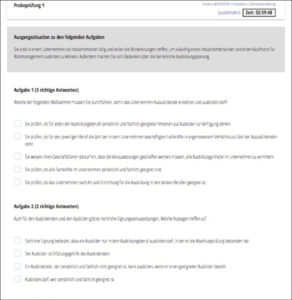 Another reason are certainly the many MOOC platforms and MOOCs (= Massive Open Online Courses), which offer a large number of free courses on a wide variety of topics worldwide. MOOCs usually consist of several videos in which teaching-learning content is conveyed through interviews, presentations and animations. In addition, you can discuss with the other participants in forums, work on test questions and are being motivated to continue learning by badges (virtual badges/reward points). You can find such MOOCs at openSAP, openHPI or mooin.
Another reason are certainly the many MOOC platforms and MOOCs (= Massive Open Online Courses), which offer a large number of free courses on a wide variety of topics worldwide. MOOCs usually consist of several videos in which teaching-learning content is conveyed through interviews, presentations and animations. In addition, you can discuss with the other participants in forums, work on test questions and are being motivated to continue learning by badges (virtual badges/reward points). You can find such MOOCs at openSAP, openHPI or mooin.
Universities are also experiencing this learning trend. Lectures are therefore increasingly being recorded here and made available to students. For example, Prof. Dr. Jörn Loviscach from Bielefeld University of Applied Sciences makes a large number of videos freely available in his Department of Engineering Mathematics and Computer Engineering and has his own YouTube channel.
What makes videos so attractive to learners?
Learning videos have many advantages for learners. We have listed the central advantages for you from a didactic and learning psychology point of view:
Learn at your own pace: Pause and rewind videos at any time. Thus, learners can learn at their own pace and repeatedly look at the part they have not yet understood. This allows learners to control their learning process themselves and thus ensure their learning success.
Learning where and when I want: learners can watch the videos when it suits them. Because learning videos are ideal for mobile devices, they can also be viewed in the morning on the train, in the evening on the sofa or in between from any location. This minimizes the hurdles to learning and makes it very attractive for learners.
Learning on Demand: We want answers exactly when we need them. Content must be available to us when we are faced with a new topic or problem. This is exactly what we achieve with learning videos. Learners find in videos quickly and easily what they look for and can immediately apply what they have learned. This not only promotes motivation, but also the sustainability of the learning process.
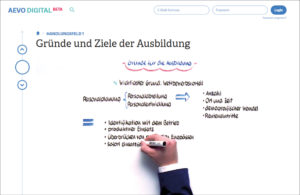 The modality effect supports the learning process: Videos work best when the teaching-learning content is presented to us both audibly – by a speaker – and visually – through animations, graphics, images. This is exactly what the empirically proven modality effect says. By addressing both sensory channels, the learning process is optimally promoted. Complex contents are thus easier to understand: While the learner looks at the visual representation, the context information is delivered to his ear and this mix of hearing and seeing significantly promotes understanding and retention. In addition, the most diverse topics can be processed in videos in a more lively, emotional and motivating way than, for example, in a WBT, which is often heavily text-intensive.
The modality effect supports the learning process: Videos work best when the teaching-learning content is presented to us both audibly – by a speaker – and visually – through animations, graphics, images. This is exactly what the empirically proven modality effect says. By addressing both sensory channels, the learning process is optimally promoted. Complex contents are thus easier to understand: While the learner looks at the visual representation, the context information is delivered to his ear and this mix of hearing and seeing significantly promotes understanding and retention. In addition, the most diverse topics can be processed in videos in a more lively, emotional and motivating way than, for example, in a WBT, which is often heavily text-intensive.
The different video formats
In the area of learning videos there are the most different terms and formats. But what is really behind it and when is which format suitable? Below you will find a list of the most frequently used formats with their advantages and disadvantages:
Real videos and talking-head videos: Different scenes are filmed in real videos. For example, conversations, interviews, statements or lectures are depicted in a video. A particularly popular form is the Talking Head video. Here, people up to their hips are being filmed while slides or pictures are shown in the background or next to the person. These videos are always suitable when the reference to the person is important or the speaker has a special meaning.
For example, as a trainer you can build up your personal relationships with your participants virtually. Pay attention to a personal address of the audience.
- Advantages: Social presence can be generated, personal contact supports motivation and promotes the activation of the participants, contents can be conveyed optimally
- Disadvantages: Too much information, for example presentation slides that are too full, too much movement or too high a speed, endangers the learning process.
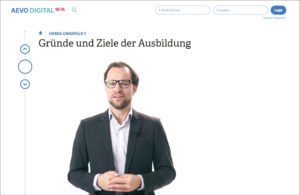 Sketch video/ Laying videos: Sketch videos, also called laying videos, are often animated videos that imitate the pen and laying technique. Graphics and texts are drawn and written by an animated hand. Of course, these videos can also be filmed in real life. In other words, the content is written on a whiteboard by a real illustrator and this process is filmed. The video is then cut so that the visualized content matches the spoken text. These videos are particularly suitable for storytelling or a creative presentation of the teaching-learning content.
Sketch video/ Laying videos: Sketch videos, also called laying videos, are often animated videos that imitate the pen and laying technique. Graphics and texts are drawn and written by an animated hand. Of course, these videos can also be filmed in real life. In other words, the content is written on a whiteboard by a real illustrator and this process is filmed. The video is then cut so that the visualized content matches the spoken text. These videos are particularly suitable for storytelling or a creative presentation of the teaching-learning content.
- Advantages: Attractive design, learners are motivated, keep attention high, content is created step by step
- Disadvantages: The production of real and authentic lay videos is very complex
Animations and cartoons: Videos showing animations or cartoons show an artificial environment. Usually, more can be shown in a cartoon than in a sketch video. Complex processes such as process engineering, processes in production or the human body, repair instructions or interpersonal communication can be explained better and more vividly in such videos. That’s why storytelling is often used in these videos as well.
- Advantages: Figures used are more personal and can show more gestures and facial expressions through animations, more complex contents can be illustrated
- Disadvantages: More elaborate in production
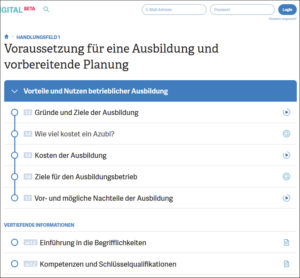 Screnncam/Screencast: Screencam or Screencasts are videos that capture the screen. For example, an application can be shown and explained step by step. The learner also sees the mouse movements in such videos and can thus understand where and when to click. These videos are therefore particularly suitable for training programs such as Excel, SAP, Word or for instructions on how to fill out a special form.
Screnncam/Screencast: Screencam or Screencasts are videos that capture the screen. For example, an application can be shown and explained step by step. The learner also sees the mouse movements in such videos and can thus understand where and when to click. These videos are therefore particularly suitable for training programs such as Excel, SAP, Word or for instructions on how to fill out a special form.
- Advantages: Simple and fast creation, many free recording programs are already available for this purpose
- Disadvantages: None unless it’s good quality
Integrating video learning into online courses – the example of AEVO digital
Videolearning offers learners many advantages for informal learning. But videos alone are not enough for an optimal learning process. Using AEVO digital as an example, we show you how you can optimally integrate videos into an online course and thus also support formal learning processes.
In most cases, preparation for the written and practical examination in accordance with the Ordinance on Trainer Aptitude (AEVO) takes place in attendance events over several days. The learners are thus up to 2 or 4 weeks at a time in the seminar and learn all necessary contents in a compact way.
AEVO digital GmbH is convinced – that works better! AEVO digital GmbH has developed an innovative and sophisticated learning format, so that learners are less absent from the workplace and employers can save on seminar, travel and accommodation costs. 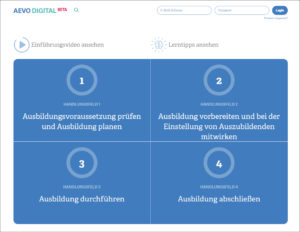 Learners register for exam preparation on the learning platform and can then learn individually, at any time and at any place. Various learning formats are available for this purpose. However, the guiding format are real laying videos, i.e. filmed whiteboard videos with narrators.
Learners register for exam preparation on the learning platform and can then learn individually, at any time and at any place. Various learning formats are available for this purpose. However, the guiding format are real laying videos, i.e. filmed whiteboard videos with narrators.
And this is how the online course is structured: On the learning platform, the learner finds all four fields of action according to AEVO as well as one area for the preparation for the theory examination and one for the preparation for the practical examination. Within each of the four fields of action, the learner learns with videos, quiz questions and in-depth scripts and can test his knowledge at the end of each field of action with a knowledge check.
The learning videos all have the same structure:
- The lecturer welcomes the participants at the beginning and introduces the contents as well as the learning goals of the video. Then he steps out of the picture.
- The teaching-learning content is then visualized step by step on a whiteboard, while the lecturer explains the content.
- At the end, the lecturer comes back into the picture, summarizes the central points, refers the learners to further suitable learning material and says good-bye to the students. Next to him, the relevant information appears in keyword form Talking-Head format.
The great advantage of this online course lies not only in the videos, but also in the didactic embedding of the videos in a learning path. The learning path shows different paths for the learners: You can start with any topic or go through the suggested sequence of action fields. The learner learns alternately with various virtual learning formats that complement each other in terms of content and didactics. Through tutorial support, the learner also has the opportunity to ask questions at any time and receives an individual and prompt professional answer. A progress check also shows the learner which content he has worked on and which content he has understood. The learning platform is structured in such a way that the learner is optimally accompanied on his learning path.
Here, virtual learning is thought of in a completely new way outside the ceded paths of web-based training.
The Author
 Josef Buschbacher
Josef Buschbacher
is Managing Director of Corporate Learning & Change GmbH and was a training manager in a large corporation for many years himself. He is a proven expert in the fields of education, change management, social media and digital learning solutions. His core competencies include the digital fitness of trainers and instructors for further education, the introduction of technological innovations in the teaching-learning sector, the consulting of companies in the field of digitisation in the training and further education landscape and the application of creative methods such as design thinking.
The Author
 Madeleine Müller
Madeleine Müller
is a Learning Consultant of Corporate Learning & Change GmbH, certified live online trainer and blended learning designer as well as design thinking trainer. Her core competencies include the qualification of trainers and trainers as live online trainers, digital learning designers and content developers as well as the conception of didactically well thought-out digital learning solutions. In addition, she advises and qualifies international clients in the field of digitization in continuing education.
The Author
 Dr. Katja Bett
Dr. Katja Bett
is Managing Director of Corporate Learning & Change GmbH, trained personnel and Organisational developer (GwG e.V.), Certified Live-Online-Trainer and has a doctorate in pedagogy on the subject of e-moderation. Her core competencies include the development of innovative personnel development and training measures through digital learning formats. She advises companies on the introduction of complex digital learning solutions. She also trains webinar trainers, digital learning designers and content developers. This also includes coaching in the individual development of competences in the field of “digitisation”.
Contact
Dr. Katja Bett
CLC – Corporate Learning & Change GmbH
Viergiebelweg 26
D-70192 Stuttgart,
Germany
Phone: +49 (0) 711 / 50 47 36 38
k.bett@clc-learning.de
www.clc-learning.de





